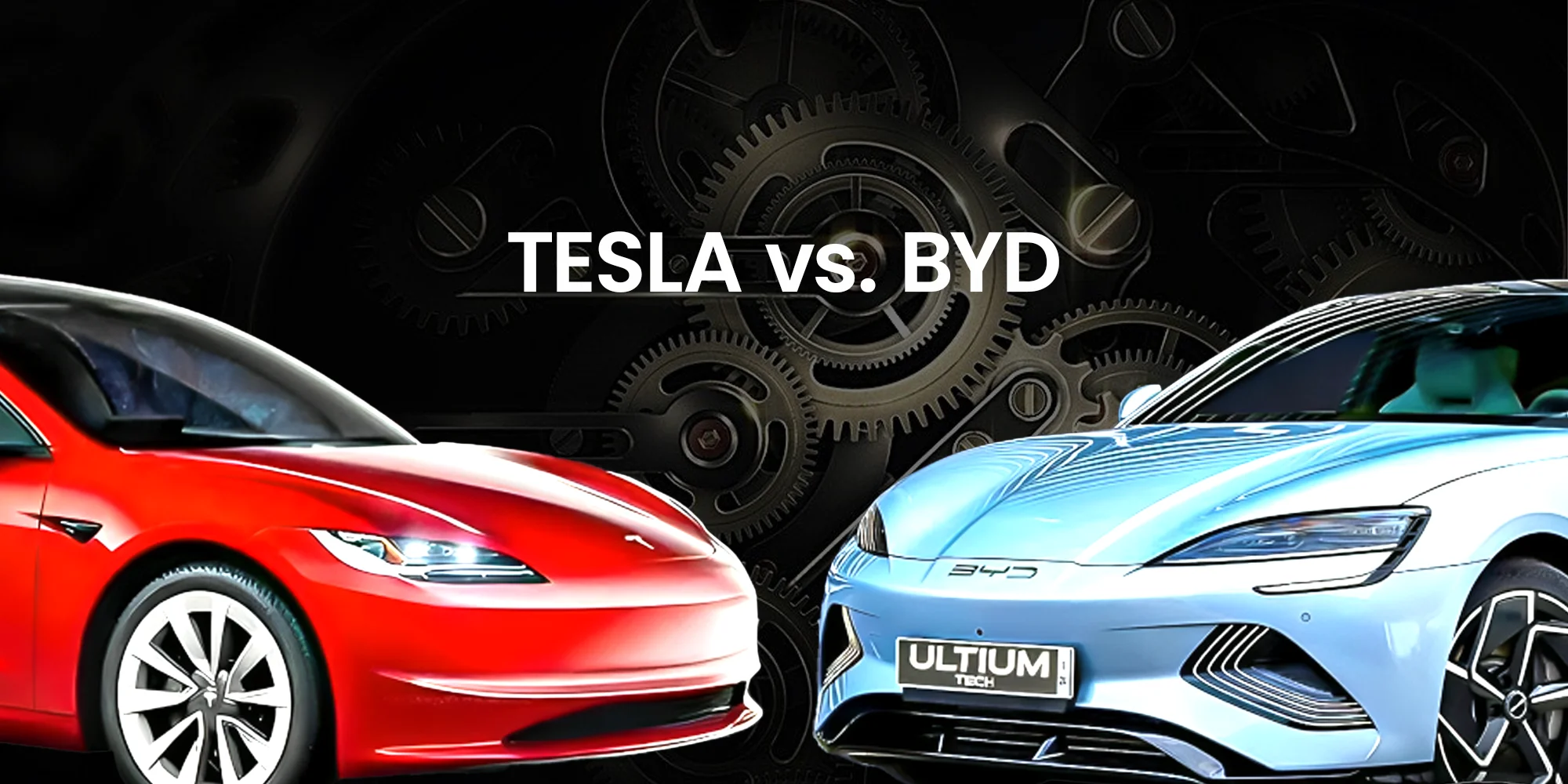Necessary Always Active
Necessary cookies are required to enable the basic features of this site, such as providing secure log-in or adjusting your consent preferences. These cookies do not store any personally identifiable data.
|
||||||
|
||||||
|
||||||
|

Two industry giants are battling for supremacy in the electric vehicle (EV) market, and what once seemed like a one-sided Tesla vs BYD contest has taken a sharp and surprising turn. Tesla, the undisputed leader in battery electric vehicle (BEV) sales from 2018 to 2022, has gradually lost its grip on the EV market to BYD, the aggressively innovative Chinese automaker.
This article explores the shifting dynamics of the high-voltage contest between the California tech-driven champion and the Shenzhen manufacturing powerhouse.
What is now a direct Tesla vs BYD competition did not start that way. While both companies entered the auto industry in 2003, Build Your Dreams (BYD) had already been operating since 1995 as a battery manufacturer in Shenzhen, China. It began producing internal combustion engine (ICE) cars in 2003 and stepped into the electric spotlight in 2008 with the F3DM, a plug-in hybrid. This marked the gradual shift until it started EV models with the launch of an all-electric e6 in 2010. BYD produced the Blade Battery in 2020, and the rest of the story reveals its rise to stardom.
Tesla, on the other hand, was founded in Palo Alto, California, in 2003. Similar to BYD, Tesla’s breakthrough was in 2008 with the launch of the Roadster – the world’s first electric sports car legal for highways and built on a Lotus chassis. The popular Model S was launched in 2012, and it has been an upward innovative trend since then. From emerging software to battery design, Tesla positioned itself as a blend of technology and an automobile company.
That gap has now closed from what appeared to be a wide margin in the global BEV market share between Tesla and BYD. Statista reports that Tesla ended Q3 2024 with 18% units sold compared to 16% by BYD. However, BYD surpassed the Tesla EV market share in Q4 2024 and has done so for the second consecutive quarter, ending Q1 2025 with sales of just over one million new-energy vehicles (NEVs). The fully electric models accounted for about 416,388 of that.
This surge in sales was expected following last year’s numbers, as CNN recently reported BYD as the top-selling EV in the world, with $107 billion in annual revenue compared to Tesla’s $97.7 billion.
Beyond BYD sales vs Tesla, the following innovative technologies explain how both EV leaders capitalize on their respective strengths.
Tesla’s electric vehicles focus on the seamless integration of their cylindrical 4680 battery cells to minimize weight. However, BYD models focus on ultra-fast charging and now have the 10C version of its Blade battery series that supports a 400 km charge in just 5 minutes. This new supercharging feature far supersedes Tesla’s 270 km in 15 minutes.

Tesla electric vehicles have a full self-driving system (FSD) built upon its Dojo supercomputer to train the neural networks. While Tesla already aims for level 4 autonomy as a key strategy towards EVs and smart cities, it is yet to have official Level 3 regulatory clearance.
BYD electric cars, as the top Tesla competition, are already integrating LiDAR, radar, and HD mapping in its systems like the DiPilot 300 and the 2024’s God’s Eye. BYD’s premium models like Denza N7 and Yang Wang U8 are approaching level 3 autonomy support for possible robotaxi services.
Tesla and BYD have taken unique but effective approaches based on their brand identity and geographical advantages.
Tesla has gigafactories in the United States, China, and Germany, with developments in Mexico and India. These factories produce millions of EVs per year, battery cells and packs, AI chips, and software through:
Unlike Tesla, BYD is not just about building EVs but becoming a “conglomerate” with experience over adjacent industries all related to automobiles through:
If Tesla is the Apple of the EV market, then BYD will be the Android of the same electric vehicle market. Tesla focuses on offering premium and high-tech features in contrast to the economy affordability of BYD.
Here is a summary of the cheapest available Tesla and BYD electric cars:
| Brand | Model | Avg. Starting Price (USD) | Avg. Range | Market Position |
| Tesla | Model 3 RWD | $38,000 | 272 miles | Entry-level Luxury EV |
| BYD | Seagull | $12,000 | 190–250 miles | Affordable city EV |
The role of government actions in shaping the competitive dynamics in the Tesla vs BYD EV market debate cannot be overlooked. A more recent example is the April 2025 125% tariff by the US on China imports that was equally imposed by China on US imports in retaliation.
Previous Chinese policies that favored BYD were subsidies for NEVs between 2020 and 2022. There is also a license plate registration priority for China EV cars and a recent double subsidy for consumers who traded their old vehicles for NEVs.
For US policies favoring Tesla electric vehicles, we have the Inflation Reduction Act of 2022, which introduced tax credits for EV purchases based on domestic sourcing and manufacturing. The US government is also investing publicly in facilities to expand EV charging networks through legislation and tax incentives.
The Tesla vs BYD race to dominate the world’s EV market is not just two competing companies but two unique philosophies. Tesla Auto continues to push the boundaries of software, intelligent automation, and global branding with bold investments in AI, supercomputing, and gigafactories. On the other hand, BYD takes the affordable route with its mastery of battery technologies, automotive depth, and support of Chinese industrial policies. This keenly contested battle for EV supremacy sparks interest as both brands position themselves for autonomous fleet management and electric mobility services.
Sign up to receive our newsletter featuring the latest tech trends, in-depth articles, and exclusive insights. Stay ahead of the curve!